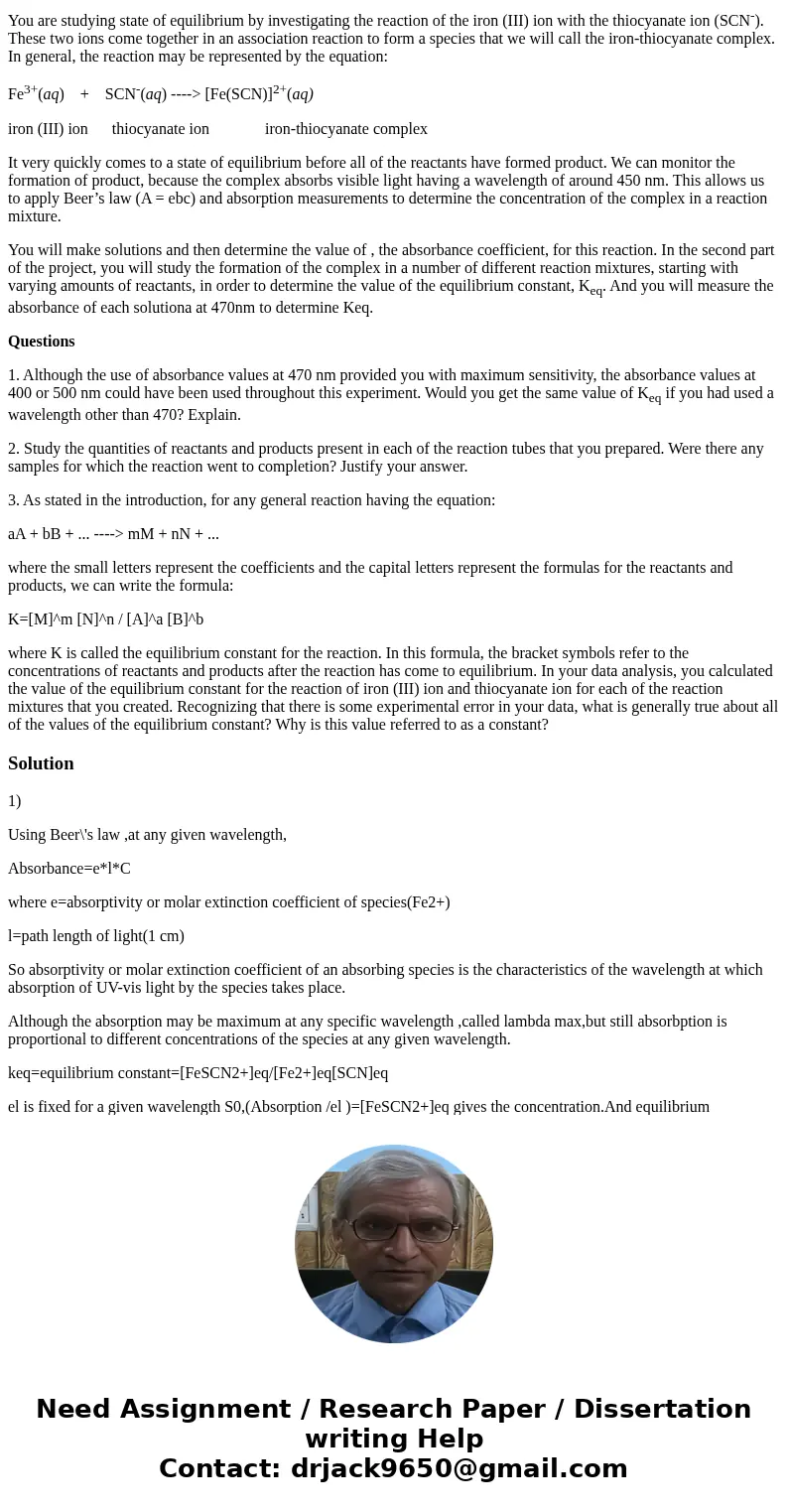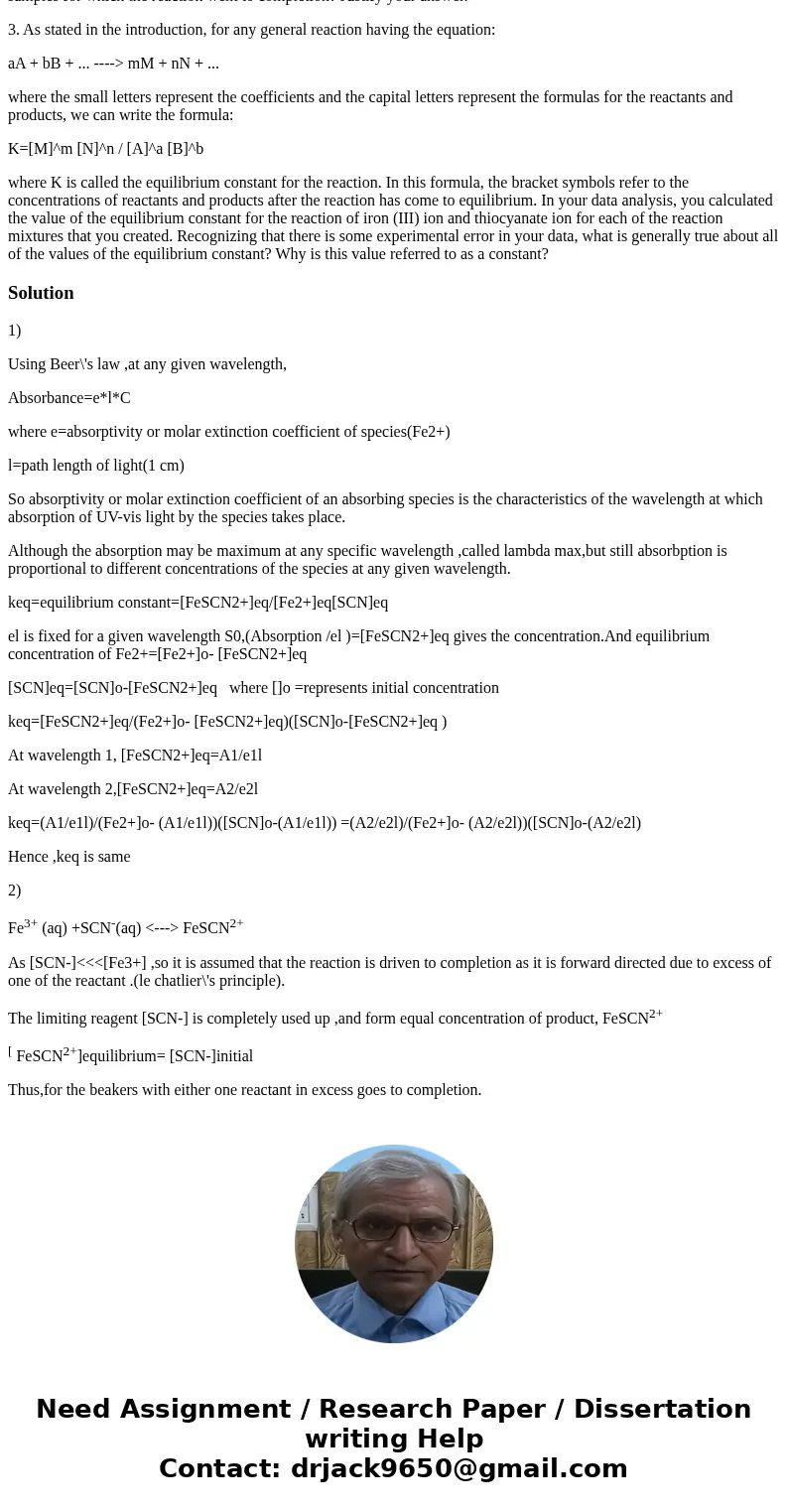You are studying state of equilibrium by investigating the r
You are studying state of equilibrium by investigating the reaction of the iron (III) ion with the thiocyanate ion (SCN-). These two ions come together in an association reaction to form a species that we will call the iron-thiocyanate complex. In general, the reaction may be represented by the equation:
Fe3+(aq) + SCN-(aq) ----> [Fe(SCN)]2+(aq)
iron (III) ion thiocyanate ion iron-thiocyanate complex
It very quickly comes to a state of equilibrium before all of the reactants have formed product. We can monitor the formation of product, because the complex absorbs visible light having a wavelength of around 450 nm. This allows us to apply Beer’s law (A = ebc) and absorption measurements to determine the concentration of the complex in a reaction mixture.
You will make solutions and then determine the value of , the absorbance coefficient, for this reaction. In the second part of the project, you will study the formation of the complex in a number of different reaction mixtures, starting with varying amounts of reactants, in order to determine the value of the equilibrium constant, Keq. And you will measure the absorbance of each solutiona at 470nm to determine Keq.
Questions
1. Although the use of absorbance values at 470 nm provided you with maximum sensitivity, the absorbance values at 400 or 500 nm could have been used throughout this experiment. Would you get the same value of Keq if you had used a wavelength other than 470? Explain.
2. Study the quantities of reactants and products present in each of the reaction tubes that you prepared. Were there any samples for which the reaction went to completion? Justify your answer.
3. As stated in the introduction, for any general reaction having the equation:
aA + bB + ... ----> mM + nN + ...
where the small letters represent the coefficients and the capital letters represent the formulas for the reactants and products, we can write the formula:
K=[M]^m [N]^n / [A]^a [B]^b
where K is called the equilibrium constant for the reaction. In this formula, the bracket symbols refer to the concentrations of reactants and products after the reaction has come to equilibrium. In your data analysis, you calculated the value of the equilibrium constant for the reaction of iron (III) ion and thiocyanate ion for each of the reaction mixtures that you created. Recognizing that there is some experimental error in your data, what is generally true about all of the values of the equilibrium constant? Why is this value referred to as a constant?
Solution
1)
Using Beer\'s law ,at any given wavelength,
Absorbance=e*l*C
where e=absorptivity or molar extinction coefficient of species(Fe2+)
l=path length of light(1 cm)
So absorptivity or molar extinction coefficient of an absorbing species is the characteristics of the wavelength at which absorption of UV-vis light by the species takes place.
Although the absorption may be maximum at any specific wavelength ,called lambda max,but still absorbption is proportional to different concentrations of the species at any given wavelength.
keq=equilibrium constant=[FeSCN2+]eq/[Fe2+]eq[SCN]eq
el is fixed for a given wavelength S0,(Absorption /el )=[FeSCN2+]eq gives the concentration.And equilibrium concentration of Fe2+=[Fe2+]o- [FeSCN2+]eq
[SCN]eq=[SCN]o-[FeSCN2+]eq where []o =represents initial concentration
keq=[FeSCN2+]eq/(Fe2+]o- [FeSCN2+]eq)([SCN]o-[FeSCN2+]eq )
At wavelength 1, [FeSCN2+]eq=A1/e1l
At wavelength 2,[FeSCN2+]eq=A2/e2l
keq=(A1/e1l)/(Fe2+]o- (A1/e1l))([SCN]o-(A1/e1l)) =(A2/e2l)/(Fe2+]o- (A2/e2l))([SCN]o-(A2/e2l)
Hence ,keq is same
2)
Fe3+ (aq) +SCN-(aq) <---> FeSCN2+
As [SCN-]<<<[Fe3+] ,so it is assumed that the reaction is driven to completion as it is forward directed due to excess of one of the reactant .(le chatlier\'s principle).
The limiting reagent [SCN-] is completely used up ,and form equal concentration of product, FeSCN2+
[ FeSCN2+]equilibrium= [SCN-]initial
Thus,for the beakers with either one reactant in excess goes to completion.


 Homework Sourse
Homework Sourse